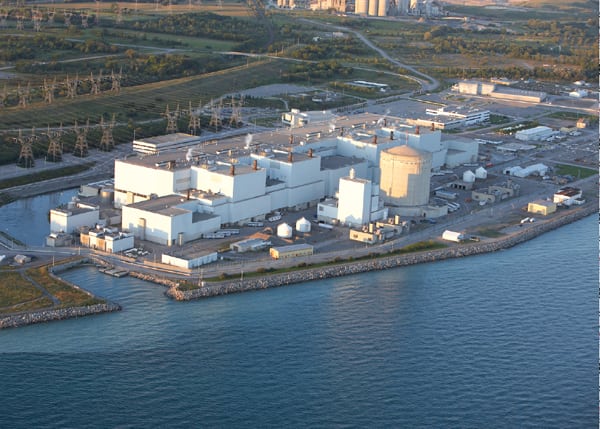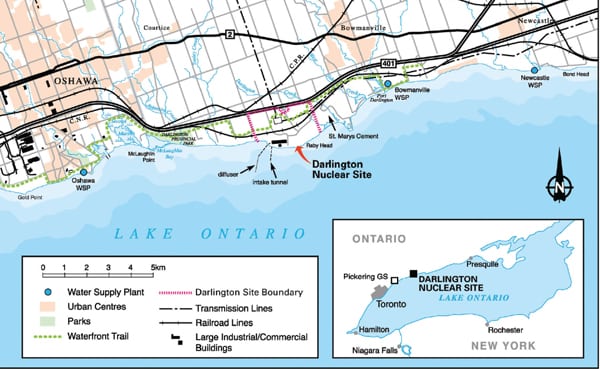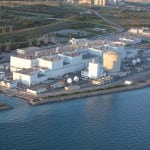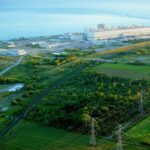The Canadian Nuclear Safety Commission has issued a License to Prepare Site for Ontario Power Generation’s Darlington station expansion. This is the first of a series of licenses required to prepare, construct, and operate new nuclear reactors and the first of its kind issued in Canada in over a quarter-century.
On August 17, 2012, the Joint Review Panel (JRP) of the Canadian Nuclear Safety Commission (CNSC) issued a License to Prepare Site (LTPS) to Ontario Power Generation Inc. (OPG) for a new nuclear power plant project at its Darlington site (Figure 1). The license application covers up to a four-unit plant expansion called Darlington B, with a maximum combined output of 4,800 MWe. However, it should be noted that the provincial government’s most recent plans call for development of only two units for a total of 2,000 MWe. OPG will be the owner and operator of the new plant if it is approved by the government.
 |
| 1. Darlington A. Ontario Power Generation (OPG) has received a License to Prepare Site (LTPS) from the Canadian Nuclear Safety Commission, the first in a series of required licenses. OPG plans to build up to two new nuclear units on its Darlington site (though the LTPS covers four potential units), east of the existing units shown here. Courtesy: OPG |
The Darlington B site is located on the shore of Lake Ontario, in the Municipality of Clarington, approximately 65 km east of Toronto (Figure 2). The adjacent site is currently home to the four-unit, 3,512-MWe CANDU Darlington Nuclear Generating Station (Darlington A), the Darlington Waste Management Facility, and a licensed used fuel dry storage facility. The portion proposed for development of Darlington B is primarily the eastern third of the plant site. Built in stages, the Darlington A units entered commercial service from 1990 through 1993 and now provide about 20% of Ontario’s electricity needs.
 |
| 2. Expansion zone. Expansion of the Darlington plant is projected to compensate for the planned decommisioning, by 2020, of the nearby Pickering Nuclear Generating Station, also owned by OPG. Courtesy: OPG |
Development of additional nuclear capacity at the Darlington site is part of a February 2011 integrated power system plan that includes refurbishment of the existing Darlington units and Bruce Nuclear Generating Station. On March 14, 2013, OPG received environmental approval for the Darlington A refurbishment, which is expected to run from 2016 to 2023 and cost between C$6 billion and C$10 billion. (The U.S. and Canadian dollars have been at virtual parity.) The province’s 2010 Long-Term Energy Plan (LTEP), which calls for nuclear supplying about 50% of total generation going forward, found the new units are necessary to replace nuclear power it will lose when its Pickering units shut down; that shutdown was originally scheduled to occur in stages between 2014 and 2016 but has been pushed back to 2020.
The 2010 plan notes that since the 2007 LTEP, which identified a need for new nuclear planning, “demand has declined and renewable generation has become a bigger contributor to the system. Investment in renewables, the reduction in demand, and the availability of natural gas have all reduced the immediate need for new nuclear. However, to preserve the long-term reliability of the system, particularly for baseload generation, additional investment in nuclear generation will be required.” Overall, by 2030, nuclear capacity is projected to be about 1,000 MW lower than in 2012 (see “Ontario Goes Coal-Free in a Decade” on p. 26).
In June last year, OPG signed agreements with Westinghouse Electric and SNC Lavalin’s Candu Energy Inc. for the preparation of construction plans, schedules, and cost estimates for two new units at Darlington. Candu Energy will be preparing for an enhanced Candu 6 reactor, while Westinghouse will be preparing for construction of its AP1000 reactor. The OPG noted that “Under the terms of the agreements, each company will be given 12 months to develop its report. The completed reports will be analyzed and forwarded to the Province for its consideration.”
Meanwhile, the JRP, whose role was to evaluate the environmental assessment (EA) portion of OPG’s site license application, concluded that OPG’s EA met the licensing requirements of Canada’s Nuclear Safety and Control Act and issued the LTPS. The JRP hosted 17 days of public hearings, held from March 21 to April 8, 2011, in Courtice, Ontario. Taking part in the hearings were 264 interveners and 14 government departments that made submissions in response to OPG’s application. This license is valid for a 10-year period through August 17, 2022.
The Canadian Regulatory Process
The regulatory process to build Darlington B began on September 21, 2006, when OPG submitted to the CNSC an Application for Approval to Prepare a Site. That application initiated the licensing process under the Nuclear Safety and Control Act (NSCA). The CNSC, analogous to the U.S. Nuclear Regulatory Commission (NRC), regulates the use of nuclear energy and materials in Canada. All new licensing applications or amendments to existing licenses require approval of the seven-member Commission Tribunal.
The Darlington B application also triggered the Canadian Environmental Assessment Act (CEAA). Proposed construction of a nuclear power plant is identified in CEAA regulations as a project for which comprehensive EA studies are mandatory. These studies are used to predict the environmental effects of a specific project, and to determine whether these effects can be mitigated, before a project is started. EAs consider impacts to components of the environment, such as air, water, and soil quality; noise; human health; Aboriginal interest, physical, and cultural heritage; and use of land resources. The EA report contains recommendations for a decision including all appropriate mitigation measures and requirements of a follow-up program.
On March 20, 2008, the federal minister of the environment announced referral of the project to a review panel pursuant to the CEAA and indicated that the CNSC and the Canadian Environmental Assessment Agency (CEA Agency) should pursue a joint EA review process. An EA requires information about potential accidents and effects on the environment that the CNSC regulations require in an LTPS. Accordingly, the JRP under the authority of the CEAA and the NSCA was established in 2009.
The Commission Tribunal (the Responsible Authority under the CEAA) must approve the EA before any further licensing action can be considered. In August 2011, the JRP submitted its EA recommendation to the Government of Canada. The JRP concluded that the project was not likely to cause significant adverse environmental effects, when implementation of proposed mitigation measures is considered, including effects of accidents, malfunctions, and malevolent acts. In May 2012, the government agreed with the JRP’s recommendation and authorized the project to proceed to the next step, issuing the LTPS. With approval of the LTPS, the JRP has met its project review responsibilities and is no longer involved with the subsequent licensing steps.
Canada’s Multiphase Licensing Process
The NSCA and related regulations require five separate license applications to be filed over the lifetime of a nuclear plant. Note that the license to operate is a separate administrative process, much like that used by the NRC in past years, though now superseded by the combined (construction and operation) license process.
License to Prepare Site. The CNSC must be satisfied that it is feasible to design, construct, and operate the facility on the proposed site in a manner that will meet all health, safety, security, and environmental protection requirements. As discussed above, the LTPS for Darlington B was issued to OPG in August 2012.
Darlington was selected because the site is large enough to accommodate up to four new reactors, the site is adjacent to a major transmission corridor, excellent support is available from the host communities, and there is access to an existing highly skilled and experienced workforce. In addition, OPG has extensive knowledge of the site dating from the development of Darlington A in the 1970s, including the surrounding lands and waters. Therefore, a large body of information already exists on the physical, biological, and social environments relative to the site and vicinity, including the near-shore aquatic environment.
OPG will undertake site preparations under the “owner-only” approach sanctioned by the Ontario Ministry of Labor. An engineering, procurement, and construction company (EPC) is responsible for the physical works to prepare the site and construct the new nuclear facilities. OPG noted that it might enter into an EPC contract for site preparation activities only, in advance of a decision on the specific reactor technology.
License to Construct. OPG must demonstrate that the proposed design of the new nuclear plant conforms to regulatory requirements and, if constructed as designed, will provide for safe operation on the designated site over the proposed plant life.
Before the license to construct (LTC) can be prepared, OPG must select a reactor technology. The Province of Ontario is responsible for procuring the new reactors and associated construction and installation services, whereas OPG will operate the reactors. It is anticipated that each new reactor will have a 60-year operating life, including mid-life refurbishment.
Licensing guidance for new nuclear power plants recognizes that an LTPS application may be submitted in advance of selecting a specific technology. Given that multiple reactor designs were still under consideration at the time of the LTPS application, OPG is using the “technology neutral” Plant Parameter Envelope (PPE) as a means of comparing several nuclear reactor technologies and bounding plant parameters, such as cooling water technology, natural hazards, and natural and environmental resources. The features of the selected design would need to fit within the bounding envelope prior to obtaining permission to construct the new plant.
The PPE concept is based on the Early Site Permit (ESP) process in the U.S., where the NRC has issued the following ESPs: Clinton ESP Site (Exelon Generation Co. LLC), Grand Gulf ESP Site (System Energy Resources Inc.), North Anna ESP Site (Dominion Nuclear North Anna LLC), and Vogtle ESP Site (Southern Nuclear Operating Co.). OPG indicated that these examples were used in the development of its PPE process.
OPG plans to undertake a formal quantitative cost-benefit analysis for cooling tower and once-through condenser cooling water systems as part of the LTC application. This analysis may be required earlier, however, given the relationship between site layout, reactor technology, and the choice of the condenser cooling technology.
License to Operate. The applicant must demonstrate to the CNSC that it has established the safety management systems, plans, and programs that are appropriate to ensure safe and secure operation in order to be awarded a license to operate the plant.
License to Decommission. The applicant must have a preliminary decommissioning plan for the activities contemplated at the end of operation. A financial guarantee must provide assurance that adequate resources will be available to fund decommissioning activities. The assurance of such a guarantee addresses the potential that the CNSC would find itself responsible for the decommissioning effort. However, OPG will continue to operate other licensed facilities at the site and retain ownership of the property. OPG has established guarantees for those facilities that include remediation costs for the Darlington site to support decommissioning and return it to a brownfield state.
License to Abandon. The applicant can abandon and restore the site to a brownfield state rather than returning the project site to its preexisting condition.
Response to Fukushima
Several environmental groups expressed concerns about the new-build plans, suggesting that the Darlington site is in an active seismic area in their testimony to the JRP during LTPS public hearings. However, Natural Resources Canada (NRCan) described the seismic characteristics of the area as very low risk of a major seismic event. For instance, the site is located in the Great Lakes region of Canada, and Lake Ontario is on the edge of the Canadian Shield, a geologically stable, mid-continental region, where the rate of occurrence of earthquakes is low.
The design basis earthquake (DBE) is defined as the ground motion with annual probability of exceedance of less than 1 in 10,000 years. Accordingly, the peak ground acceleration for the Darlington site is 0.209 g. OPG’s proposed designs assume a DBE as 0.3 g. In addition, a magnitude 9.0 earthquake like the one at Fukushima is not credible for Canadian inland sites, and neither is a tsunami. Canadian nuclear plants are located in areas of much lower seismic hazard risk than Fukushima. Satisfied, the CNSC concluded that there are no geotechnical issues and the seismic risk is low in the region.
However, the CNSC previously established new plant design requirements to prevent the failure experiences at Fukushima. Those include preventing station blackout, mitigating severe accidents, and preventing hydrogen migration. These requirements must be incorporated in the plant design basis, beyond design basis, and severe accident management programs, consistent with international practices, that will be incorporated at the time of an LTC application.
Next Step: License to Construct
OPG will continue to report on the licensed activities and commitments made during the EA. CNSC staff will also present annual updates to the Commission Tribunal as a part of the annual CNSC Staff Integrated Safety Assessment of Canadian Nuclear Power Plants Report.
The next step in the regulatory process is for OPG to submit its application for an LTC. OPG must demonstrate that the site-specific characteristics identified in the LTPS application are considered as part of the design basis of the reactor technology selected for construction. The public will have an opportunity to comment on OPG’s application to construct, as well as its application to operate, at future public hearings. OPG and CNSC staff will present their mid-term reports at a public proceeding of the Commission scheduled for September 2017.
— James M. Hylko (jhylko1@msn.com) is a POWER contributing editor.









